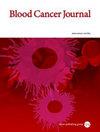Daratumumab plus lenalidomide maintenance in newly diagnosed multiple myeloma after transplant: AURIGA subgroup analyses.
IF 11.6
1区 医学
Q1 HEMATOLOGY
引用次数: 0
Abstract
In the primary analysis (32.3-month median follow-up) of the randomized, phase 3 AURIGA study (NCT03901963), daratumumab-lenalidomide (D-R) maintenance significantly improved MRD-negative conversion rates and reduced the risk of disease progression or death by 47% versus R maintenance in anti-CD38 monoclonal antibody-naïve and post-transplant MRD-positive patients with newly diagnosed MM. Here, we present a post hoc analysis across relevant subgroups, including high-risk cytogenetic abnormalities (HRCAs) per original, revised, and modified International Myeloma Society (IMS) 2024 criteria. MRD-negative (10-5) conversion rates by 12 months of maintenance were higher for D-R versus R across cytogenetically high-risk subgroups per original (31.8% vs 6.7%), revised (43.8% vs 13.3%), and modified IMS 2024 (41.2% vs 0%) criteria and cytogenetically ultra-high-risk disease (≥2 revised HRCAs; 54.5% vs 0%). Similar trends in overall MRD-negative conversion rates were observed across subgroups. D-R demonstrated a trend towards improved PFS versus R (HR [95% CI]) in cytogenetically high-risk subgroups per original (0.60 [0.21-1.70]), revised (0.53 [0.21-1.31]), and modified IMS 2024 (0.45 [0.13-1.53]) criteria and cytogenetically ultra-high-risk disease (0.61 [0.17-2.25]). Similar outcomes were observed regardless of age or race, with no additional safety concerns among older (≥65 years) or Black patients. These data support the benefit of D-R maintenance regardless of age, race, and risk status.达拉单抗加来那度胺维持移植后新诊断的多发性骨髓瘤:AURIGA亚组分析
在AURIGA随机3期研究(NCT03901963)的初步分析(中位随访33.3个月)中,在抗cd38单克隆antibody-naïve和移植后mrd阳性的新诊断MM患者中,维持daratumumab-lenalidomide (D-R)可显著提高mrd阴性转阴率,并将疾病进展或死亡风险降低47%。包括根据原始、修订和修改的国际骨髓瘤协会(IMS) 2024标准的高危细胞遗传学异常(hrca)。维持12个月的mrd阴性(10-5)转换率在细胞遗传学高危亚组的D-R和R中更高,每个原始(31.8%对6.7%)、修订(43.8%对13.3%)和修订IMS 2024(41.2%对0%)标准和细胞遗传学超高危疾病(≥2个修订HRCAs; 54.5%对0%)。在各个亚组中观察到总体mrd阴性转换率的类似趋势。在细胞遗传学高危亚组(原始(0.60[0.21-1.70])、修订(0.53[0.21-1.31])和修订IMS 2024(0.45[0.13-1.53])标准和细胞遗传学超高危疾病(0.61[0.17-2.25])中,D-R显示出改善PFS的趋势(HR [95% CI])。无论年龄或种族,观察到相似的结果,在老年人(≥65岁)或黑人患者中没有额外的安全性问题。这些数据支持D-R维持的益处,与年龄、种族和风险状态无关。
本文章由计算机程序翻译,如有差异,请以英文原文为准。
求助全文
约1分钟内获得全文
求助全文
来源期刊

Blood Cancer Journal
ONCOLOGY-
CiteScore
16.70
自引率
2.30%
发文量
153
审稿时长
>12 weeks
期刊介绍:
Blood Cancer Journal is dedicated to publishing high-quality articles related to hematologic malignancies and related disorders. The journal welcomes submissions of original research, reviews, guidelines, and letters that are deemed to have a significant impact in the field. While the journal covers a wide range of topics, it particularly focuses on areas such as:
Preclinical studies of new compounds, especially those that provide mechanistic insights
Clinical trials and observations
Reviews related to new drugs and current management of hematologic malignancies
Novel observations related to new mutations, molecular pathways, and tumor genomics
Blood Cancer Journal offers a forum for expedited publication of novel observations regarding new mutations or altered pathways.
 求助内容:
求助内容: 应助结果提醒方式:
应助结果提醒方式:


